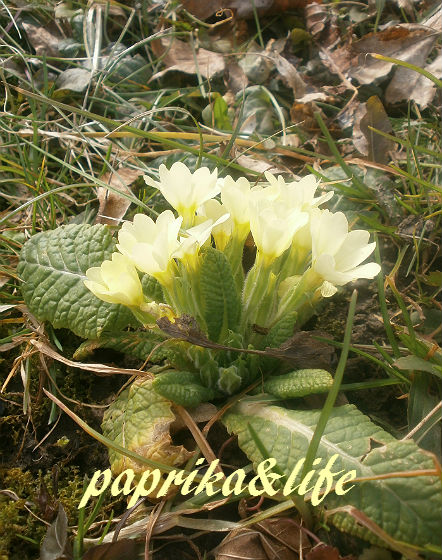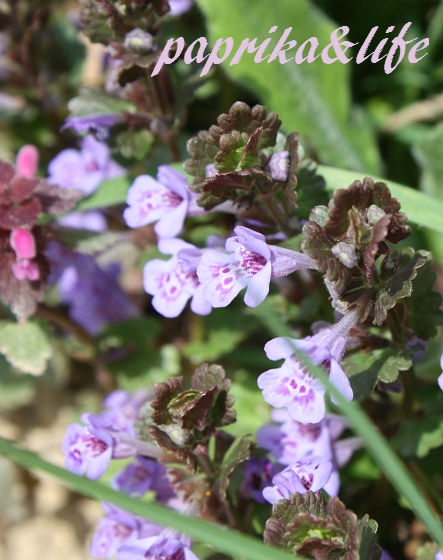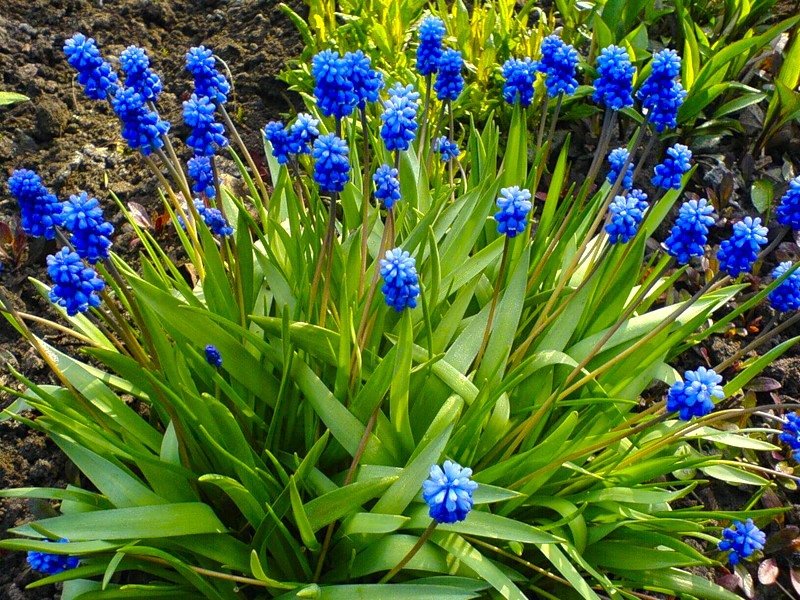
The name of the primrose is blue. The best spring flowers for the garden
Annual. It reaches a height of up to 70 cm. The leaves are sharp. The flowers are small - up to 5 mm. Flowering occurs from May to August. Fruiting - from June to September. It prefers to grow in weedy meadows and forests, near water bodies, in vegetable gardens.
Perennial. It reaches a height of 60 cm. The rhizome is short. Flowers 2.5 cm in diameter, golden yellow. Flowering occurs from April to June. Prefers bright places, humus soils.
Height - up to 30 cm. The flowers are tubular-bell-shaped, the color is first pink, then blue-violet. Flowering occurs from April to May. Prefers shade, grows in fresh, mineral-rich soils. Has healing properties.
Perennial. It reaches a height of 20 cm. The flowers are large, bell-shaped, solitary. Color - blue-violet. Flowering occurs from April to May. Prefers dry open places. Poisonous.
Perennial. It reaches a height of up to 12 cm. The leaves are collected in a rosette. The flowers are odorless, light purple. Flowering occurs from April to June.
Variety of primrose species
In total, there are about 500 species of primroses in the world. They differ in the shape and color of the leaves, flowering time. Many species are medicinal.
- The tall primrose is actually a short plant. Its length reaches only 40 cm. The flowers are light yellow. Prefers loose and moist soils, shade. Often found in Altai and Asia Minor. It is absent in the wild on the territory of the Russian Federation.
- Powdery primrose in length grows up to 20 cm. Its foliage is covered with yellow or white powdery coating. The color of the flowers is purple-pink, lilac. Inside each flower there is a bright eye - it reaches 1 cm. In the wild, primroses can be found in the northern part of European Russia, on Far East and southern Siberia. Decoctions and infusions made from this plant are actively used to treat dermatitis.
- Spring primrose is a perennial. Its height reaches 30 cm. The stem is leafless, the rhizome is short. The tops of the leaves are slightly blunt. The flowers are bright yellow, have a honey smell. The fruit is a multi-seeded brown capsule. The leaves contain ascorbic acid.
Features of care
Absolutely all primroses are not demanding in care. It is enough to find a suitable place for them in the garden, and in the spring it will be possible to observe a whole carpet of plants.
Primroses prefer partial shade and moist soil. They can be referred to. When planted in dry, unshaded areas, plants can be affected by diseases.
There is no need to fertilize, but if you wish, you can add compost and humus. Be sure to remove dry leaves and separate overgrown bulbs.
Landing is carried out in the fall. But you can just buy ready-made primroses in pots and plant them in the spring. Hyacinths and crocuses take root very quickly. Hellebore and lungwort are planted right in the spring. Reproduction in this case occurs by dividing the bush.
How to use in landscape design
Primroses are a real find for those involved in landscape design. There are several ways to use them.
- Planting near shrubs and trees.
- Placement among perennials in a flower bed.
In the first case, primroses will grow well, as shrubs and trees will reliably protect them from various adverse weather conditions. In the second, it will be possible to achieve continuous flowering. After the primroses fade, they will be replaced by perennials.
If you have chosen primrose, its various varieties look great in a group.
Important! Since flowering primrose can cause an allergic reaction, it is necessary to work with it with gloves.
Primroses, characterized by early flowering, look spectacular in plantings with other spring plants. Of the neighbors, she will suit:
- viper bow;
- lungwort;
- daffodils;
- forget-me-not.
Jaundice leftkoy is often planted in rabatka or does not take much time. Low plant varieties look great in rockeries and rock gardens. For a rustic style, the presented primrose is just perfect. Flower beds with jaundice look great near the paths. It is recommended to combine the flower with herbaceous perennials and annuals of bright color.
Kashubian ranunculus will be an excellent option for flowerbeds and flower beds. An obscure lungwort is best placed in groups in a mixborder. Shrubs, uvularia, kupena, hostas, ferns and corydalis will become excellent neighbors for her. The plant looks perfect in ridges and borders.
Open backache, or sleep-grass, is not so common in landscape design. It is difficult to care for it, and many gardeners do not risk planting a plant. But if you take a chance, the backache will become a real decoration of the site. Flowering is very beautiful, fluffy fruits also look very touching.
Primroses (video)
Since in nature the marsh violet grows in swampy wetlands, in the garden it will also have to choose a place with similar conditions. It is planted near streams, ponds and artificial swamps.
Primroses are the real heralds of spring. There are many types of early flowering plants, and all of them can be a real decoration for your site!
Small overview
When the snow begins to melt in the fields and forests, the time comes for the first spring flowers. We call them by the common word "primroses". Many of them bloom in some European latitudes as early as February - even where snow is now rarely seen :) We are also interested in them because they can also be found in the wild in our cultivated vegetable gardens. To help summer residents I will show a few photos.
Primroses - this is the name of a whole family of plants, the representative of which is Common primrose, or common primrose (lat. Primula vulgaris).

Another primrose:

Spring primrose, or Primrose officinalis, or real primrose, or spring primrose (lat. Prímula véris). Photo: Wikipedia
In some regions, any first spring flowers are called "snowdrops", but according to botanical nomenclature, the "correct" snowdrop looks like this:

Snowdrop, or Galanthus (lat. Galanthus). There are several species of this plant that are poisonous. In the photo - Galanthus nivalis. Photo: Wikipedia
One of the first to bloom is chionodoxa, which is sometimes confused with the Siberian blueberry.

Chionodox (Chionodoxa); Snowman; Snow beauty. Photo: www.weerkust.ru

Siberian spelling (lat. Scilla siberica). Photo: Wikipedia
In some regions, the blueberry is called the liverwort.

Noble liverwort (Hepatica nobilis), or coppice. Poisonous plant. The white flowers next to it are oak anemone (lat. Anémone nemorósa). Care must also be taken when working with it, as with all ranunculus.
And this is another windmill.

Buttercup anemone, or ranunculus anemone, or ranunculus anemone (lat. Anemóne ranunculoides). Poison plant!

It is sometimes confused with another plant from the same family, which is called springweed, but if you look closely, the differences are visible to the naked eye.

Winter erantis, or wintering vesennik, Eranthis hyemalis (see also header photo)
It's bloomed lungwort (Pulmonaria).

And it blooms corydalis (lat.Corýdalis).

This is what it looks like in color:

Corydalis are also considered poisonous. Photo: www.vespabellicosus2008.narod.ru

Goose onion (lat. Gagea)

Common coltsfoot (lat.Tussilago farfara). In this plant, leaves appear later than flowers. Photo: www.vespabellicosus2008.narod.ru
In the wild, you can find both crocus and muscari (mouse hyacinth).

Crocus (lat. Crocus)

Viper onion, or Mouse hyacinth, or Muscari (lat. Muscári). Photo: Wikipedia

Backache (lat. Pulsatilla) blooms later, in some regions called "sleep-grass". Common lumbago is a poisonous plant.
Beautiful flower carpets create different types tenacious and clear, which also bloom a little later than the very first flowers.

Creeping tenacious (Ajuga reptans L.), or dubrovka. Photo: www.files.school-collection.edu.ru

Purple lamb (lat. Lamium purpureum). Yellow flower next to her - clean, which is sometimes confused with marigold.

Spring chistyak, or spring buttercup (lat. Ficaria verna).
And the marigold looks like this and in our gardens it is very, very rare:

Marsh marigold (lat.Caltha palustris). She has only 5 petals; poisonous plant. Photo: Wikipedia
Well, just in case :) Plants that in some latitudes can bloom in January.

Veronica oak (lat. Veronica chamaedrys)

Daisy perennial (lat. Béllis perénnis)

Ivy-shaped Budra, Creeping Budra, (lat. Glechóma hederácea); sometimes called dognip or catnip. The plant has a pleasant aroma, but is also considered poisonous.
I won’t show the dandelion, everyone seems to know it :) Instead, I’ll show the beautiful violet.

Fragrant violet (lat. Viola odorata). The most fragrant primrose! Some reference books consider it a conditionally poisonous plant. *
* "IN contemporary literature Poisonous plants are considered to be those that produce toxic substances (phytotoxins), even in small quantities causing death and damage to the body of humans and animals. However, such a definition contains a certain measure of conventionality. "(B.N. Orlov, D.B. Gelashvili, A.K. Ibragimov. Poisonous animals and plants of the USSR). Most researchers divide such plants into highly poisonous, poisonous and conditionally poisonous.
After frost and a cold winter, nothing will cheer you up like the first spring primroses that break through the snow and herald the approach of spring. Early flowers are resistant to cold, unpretentious and multiply very quickly. Thanks to all these qualities, they are great for decorating summer cottages, parks, squares, etc. Quite often, the first spring flowers are also used in landscape design, creating compositions of incredible beauty. This article presents the best primroses for summer cottages, as well as the features of their cultivation.
Features of choosing a place for primroses in the garden: where to plant primroses
Since all garden primroses are winter-hardy, they prefer to grow in semi-shady places. If they are planted on the sunny side, then in the summer when direct light hits them, the leaves of the primroses will dry, and the plant will go into the winter without leaves. The following year, such flowers bloom poorly and may simply die. Early garden flowers go under the snow with green leaves. They grow quite quickly, within 3-4 months per season. After that, they begin a dormant period.
Did you know?Good neighbors will be perennials that start growing in late spring, as well as creeping and low perennials, through which flowers will easily sprout.
 Tuberous and bulbous primroses grow well in loose fertile soil, in a slightly darkened place. Before planting them it is necessary to prepare the soil in 2-3 weeks. It needs to be dug up, all weeds removed, and then add a layer of compost and mix. Instead of compost, you can use a multi-component fertilizer. The first spring plants are able to grow and delight with their beauty for about 5-6 years, but they should be planted in the same place no earlier than after 5 years.
Tuberous and bulbous primroses grow well in loose fertile soil, in a slightly darkened place. Before planting them it is necessary to prepare the soil in 2-3 weeks. It needs to be dug up, all weeds removed, and then add a layer of compost and mix. Instead of compost, you can use a multi-component fertilizer. The first spring plants are able to grow and delight with their beauty for about 5-6 years, but they should be planted in the same place no earlier than after 5 years. Planting spring primroses, the use of plants in landscape design
You can admire the bright colors of primroses even when there is still snow in places. spring primroses unpretentious and you can create an incredible number of compositions using beautiful spring flowers in landscape design. With their help, you can decorate summer cottages, ponds, rock gardens, or you can simply plant them in pots or containers.
Heralds of spring in the meadow
The first spring plants can be planted both in summer cottages and in the meadow. On the lawn, miniature bulbs, such as blueberries, muscari or crocuses, will look very beautiful.
Did you know? The most effective will be massive plantings, that is, planting the bulbs tightly to each other and in large numbers.
 When caring for your lawn, keep in mind that you need to mow the grass at a certain time so as not to damage the flowers. This should be done when the primroses have completed their annual cycle of ground vegetation, and their leaves have died off naturally.
When caring for your lawn, keep in mind that you need to mow the grass at a certain time so as not to damage the flowers. This should be done when the primroses have completed their annual cycle of ground vegetation, and their leaves have died off naturally. What primroses to plant near a pond
If there is a reservoir on your site and you want to plant primroses near it, then some nuances should be taken into account. When choosing, give preference to moisture-loving primroses– they will feel best near the water. On a mixed border, these flowers will look good with summer bulbs as well as perennials.
Planting heralds of spring in rock gardens and mixborders
If you want to create an “alpine” composition on your site, then early flowering plants are perfect here, here are the names of some of them:
- crocuses;
- hyacinths;
- snowdrops, etc.
 They must be planted in groups, in which case they will create colorful spots when flowering, and your rock garden will look great. The same applies to the mixborder, the foreground of which can be decorated with undersized primroses. Alternatively, you can plant them between perennials that have large ornamental leaves. Perennials will block the voids that will form when the leaves of primroses dry out, and retain the decorative appearance of the entire composition.
They must be planted in groups, in which case they will create colorful spots when flowering, and your rock garden will look great. The same applies to the mixborder, the foreground of which can be decorated with undersized primroses. Alternatively, you can plant them between perennials that have large ornamental leaves. Perennials will block the voids that will form when the leaves of primroses dry out, and retain the decorative appearance of the entire composition. Spring primroses for pots and containers
Almost all primroses are successfully grown indoors. To do this, you can use pots, containers, planters, flowerpots. The main thing in this matter is to provide the plants with conditions that are as close to natural as possible. However, the agricultural technique for growing certain primroses in greenhouses can differ markedly, so this issue must be approached individually. But there is no doubt: dense plantings of primroses will look chic, especially in the spring, wherever you plant them.
Complete list of spring primroses
Spring flowers have many types, but there are the most popular names that are best grown in our area.




Irises spring blooming 


Hionodoxa (snowman, snow beauty) 



















Features of growing primroses in a summer cottage
Best time for planting primroses - autumn, More precisely, the end of September - the beginning of October. It is this period that is recommended for planting, so that young plants have time to take root and at the same time do not grow before the onset of frost. Before planting, experienced gardeners recommend keeping corms and bulbs in a pink solution of potassium permanganate for half an hour.
Important! If there is a danger of damage to the bulbs by pests, then before planting, if necessary, they are treated with pesticides.
The bulbs are planted at a depth of three times the bulb itself, and the distance between them is about three diameters. It takes 3-4 weeks for the bulbs to take root. When the ground freezes a little and constantly low temperatures are established, the primrose planting site is mulched with dry leaves, peat or straw.
Important! Never cover primroses in warm weather, as they can germinate. If this happens, then with the onset of cold weather, the plants will die.
So keep an eye on the weather. Cover times may vary depending on temperature. In the spring, when frosts no longer threaten the plants, the mulch is removed. It is highly desirable to do this before the first sprouts appear.
Was this article helpful?
Not really